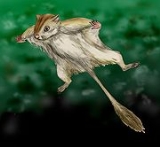
Eomyidae
Encyclopedia
Eomyidae is a family
of extinct rodent
s from North America
and Eurasia
related to modern day pocket gopher
s and kangaroo rats
. The family includes the earliest known gliding rodent, Eomys
(Storch et al., 1996)
Family (biology)
In biological classification, family is* a taxonomic rank. Other well-known ranks are life, domain, kingdom, phylum, class, order, genus, and species, with family fitting between order and genus. As for the other well-known ranks, there is the option of an immediately lower rank, indicated by the...
of extinct rodent
Rodent
Rodentia is an order of mammals also known as rodents, characterised by two continuously growing incisors in the upper and lower jaws which must be kept short by gnawing....
s from North America
North America
North America is a continent wholly within the Northern Hemisphere and almost wholly within the Western Hemisphere. It is also considered a northern subcontinent of the Americas...
and Eurasia
Eurasia
Eurasia is a continent or supercontinent comprising the traditional continents of Europe and Asia ; covering about 52,990,000 km2 or about 10.6% of the Earth's surface located primarily in the eastern and northern hemispheres...
related to modern day pocket gopher
Pocket gopher
The pocket gophers are burrowing rodents of the family Geomyidae. These are the "true" gophers, though several ground squirrels of the family Sciuridae are often called gophers as well...
s and kangaroo rats
Heteromyidae
The family of rodents that include kangaroo rats, kangaroo mice and rock pocket mice is the Heteromyidae family. Most heteromyids live in complex burrows within the deserts and grasslands of western North America, though species within the Heteromys and Liomys genera are also found in forests and...
. The family includes the earliest known gliding rodent, Eomys
Eomys
Eomys is an extinct genus of eomyid rodent from the late Oligocene of France, Germany, Spain, and possibly Turkey. One species, Eomys quercyi, is the earliest known gliding rodent .-Sources:...
(Storch et al., 1996)

